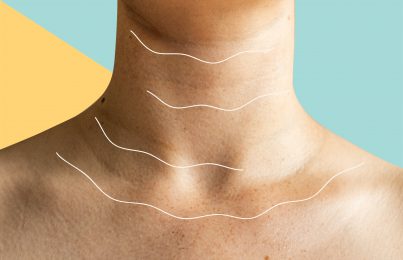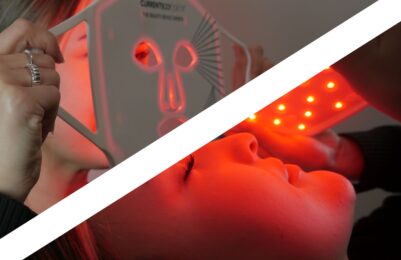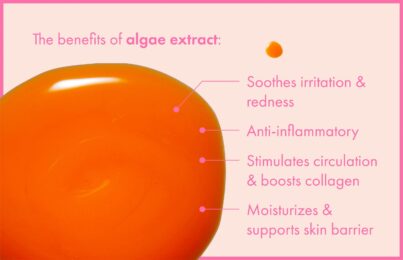An emerging trend in skincare is products that protect the skin against “digital aging” from blue light. Blue light is a type of high-energy visible light that has been proven to negatively affect skin when it comes to hyperpigmentation and visible signs of aging.
But how worried should you be about digital aging, and what can you do about it? In this post, I’ll share which skincare products and ingredients are actually proven to protect against blue-light damage. I also spoke with Dr. Kavita Mariwalla of Mariwalla Dermatology to learn more about exactly what blue light is and how we’re being exposed to it (the answer might surprise you!).
What is Blue Light, and How Much is It Damaging Our Skin?
According to Dr. Mariwalla, blue light is considered a type of high-energy visible light. “The sun produces ultraviolet (UV) radiation, which is invisible, and that’s what we use sunscreen for,” she says. “Actual sunshine, on the other hand, is considered visible light. It’s made up of a spectrum of all the colors of the rainbow (remember Roy G. Biv?). Blue light is one of the wavelengths in this spectrum. Your screens emit some of that blue light as well.”
Probably the most important thing to take away from this is that blue light is emitted by the sun—it’s not something brand new we were suddenly exposed to after technology became part of our daily lives. There’s been so much emphasis on concerns about how blue light emitted by screens is affecting our skin, but studies have shown we get significantly more blue light exposure from sunlight than we ever could from our devices. Blue light penetrates much deeper into the skin than UV rays, so it’s definitely worth having on your radar.
How Does Blue Light Impact the Skin?
So the good news is your screens are emitting far less damaging blue light than you probably thought, but the bad news is you’re still getting a healthy dose of blue-light exposure from the sun every day. But why is this important? How is blue light actually affecting our skin?
“The kicker with blue light is, if you have any issues with hyperpigmentation, you’re in trouble,” Dr. Mariwalla says. “Blue light from screens and the sun can increase melasma, freckling, and other pigmentation, which can lead to blotchy-looking skin over time.”
Dr. Mariwalla notes this isn’t the only way blue light can negatively impact our skin as studies have shown it can also have the following effects:
- Increase hyperpigmentation, leading to uneven skin tone
- Make under-eye darkness worse
- Cause sallow-looking skin
- Promote more fine lines and wrinkles
- Induce oxidative stress via both reactive oxygen species (ROS) and reactive nitrogen species (RNS)
To make matters worse, blue light from screens is also known to disrupt sleep cycles and cause premature aging of the eyes. No one looks their best without good beauty rest, and damaged or strained eyesight can cause squinting, which can accelerate the formation of fine lines and wrinkles around the eyes.
At the end of the day, the scientific community is somewhat split on the extent to which blue light from screens is actually affecting our skin. Some say it can make a real impact, while many others don’t believe it’s enough to make a difference. That said, no one doubts the amount of blue-light exposure we’re getting from the sun or the effects it can have on our skin. I believe it’s worth erring on the side of caution and taking steps to protect your skin against possible blue-light damage, especially if you spend a lot of time in front of a screen for work and/or have hyperpigmentation concerns.
What Are the Best Skincare Products and Ingredients to Prevent Blue-Light Damage?
Luckily, some of the products and ingredients you can use to protect your skin against blue light are probably already part of your daily routine. Here’s exactly what to use to protect yourself against blue light.
1. Wear a Tinted, Broad-Spectrum Sunscreen
You already know it’s important to wear a broad-spectrum sunscreen each and every day to protect your skin against harmful UVA and UVB rays emitted by the sun. Mineral sunscreens, which protect using either titanium dioxide, zinc oxide, or a mix of the two, offer some protection against blue light as well.
That said, a visible light study published last year in the Journal of Drugs and Dermatology found that iron oxides (commonly used to give tinted complexion products their pigment) offered significantly more protection against blue-light-induced pigmentation than mineral sunscreens do.
Translation? Mineral sunscreen filters offer some protection against blue light on their own, but wearing a tinted, broad-spectrum sunscreen of any kind is the best way to protect your skin against blue-light damage.
Learn more about the difference between physical and chemical sunscreens.
2. Use Complexion Makeup
Yes, you read that right! Makeup can be an important tool for protecting your skin against visible light. The same visible light study showed that any products (not just sunscreen) containing iron oxides offered significant protection against pigmentation triggered by blue light. The majority of complexion makeup, be it tinted moisturizer, liquid foundation, powder foundation, or concealer, uses iron oxides to get its pigment. This is one of the reasons I suggest people wear some kind of foundation makeup every day as a form of protective skincare.
If your skin is prone to clogged pores, see my list of the best liquid foundations.
3. Use Skincare Products With Antioxidants
One of the ways blue light has been shown to damage skin is through oxidative stress. This is caused by free radicals, and the best way to combat them is by applying a variety of antioxidants to the skin in the morning and, if you can, at night.
What about products that make blue-light marketing claims?
All antioxidants will help mitigate blue-light damage, but there are a few that have been tested by suppliers specifically to determine how well they defend against blue light. Some examples include Hedychium Coronarium (Butterfly Ginger) Root Extract, Theobroma Cacao (Cocoa) Extract, and certain algae extracts. If a company is selling a product that makes blue-light claims, they should be using an extract that’s been specifically tested against blue light.
What Else Can I Do to Protect My Skin From Blue Light?
While topical skincare products are by far the best way to make sure you’re protected against the effects of blue light, there are a few non-skincare options that can be helpful as well.
- Shield your skin from blue light with a screen protector (I have one on my phone)
- Get a blue-light resistant coating on your eyeglasses
- Eat a diet rich in antioxidants
- Avoid direct sun exposure during peak daylight hours
While blue light is definitely something that can lead to issues like hyperpigmentation and premature signs of aging, less of it is coming from your screens than you may think. The biggest source of blue light we encounter in our daily lives is the sun, but thankfully there are steps we can take (and products we can use) to mitigate its damaging effects. I know there are a lot of companies out there making claims about blue light and that it can be confusing, so I hope this post clears things up and helps you understand what to invest in so your skin stays protected!
Next, learn how using technology leads to “tech neck” and what you can do to treat and prevent it.
Celebrity Esthetician & Skincare Expert
As an esthetician trained in cosmetic chemistry, Renée Rouleau has spent 35 years researching skin, educating her audience, and building an award-winning line of products. Her hands-on experience as an esthetician and trusted skin care expert has created a real-world solution — products that are formulated for nine different types of skin so your face will get exactly what it needs to look and feel its best. Trusted by celebrities, editors, bloggers, and skincare obsessives around the globe, her vast real-world knowledge and constant research are why Marie Claire calls her “the most passionate skin practitioner we know.”



